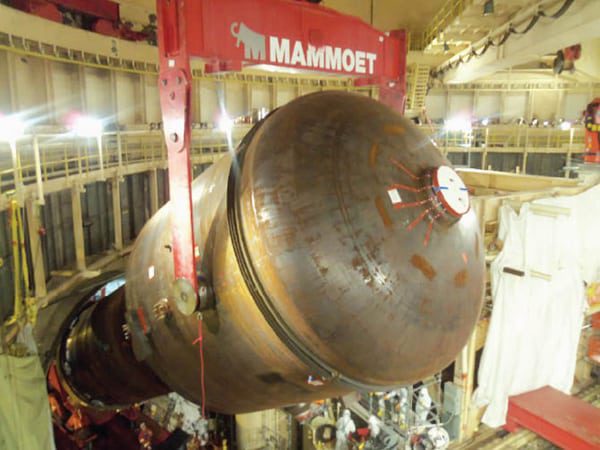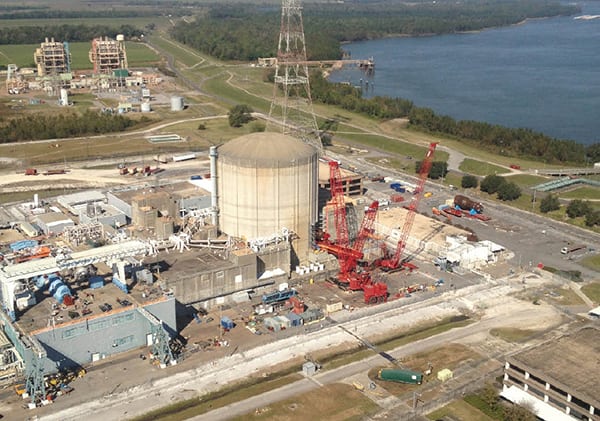Top Plant: Waterford 3 Steam Electric Station, Killona, Louisiana
Nuclear plant steam generator replacements are difficult in the best of circumstances. Entergy had to face component delays, staffing shortages, and even a hurricane while upgrading its Waterford 3 plant. Sterling teamwork and project management brought the operation to a successful conclusion.
The Waterford 3 Steam Electric Station has been providing power to the Gulf Coast since 1985, when Entergy—then Louisiana Power & Light—first brought the plant online along the Mississippi River in Killona, La., about 25 miles west of New Orleans. The single-unit plant employs a two-loop Combustion Engineering pressurized water reactor rated at 1,159 MW net. The plant has been a key element of the area grid, having managed an admirable 100% capacity factor in 2010, according to the Nuclear Regulatory Commission.
But in the mid-2000s, after more than 20 years of operation, the time had come to make arrangements to replace the plant’s two aging steam generators. Entergy contracted with SGT, a URS/AREVA joint venture, to supply management, engineering, and construction for the project, which would also involve replacement of the reactor vessel closure head. SGT was brought in as a result of its experience in performing more than 20 similar operations worldwide.
Project planning began in the mid-2000s and continued after the Louisiana Public Service Commission confirmed in 2010 that replacement of the steam generators was in the public interest. Though replacing nuclear reactor steam generators is a well-understood and standard operation, it is far from being without risk. It is typically the most challenging event plant owners will go through, and the risks can extend all the way up to complete loss of the plant. Though the large majority of such operations go successfully, several recent steam generator replacements in the U.S. have not.
The worst example is surely Progress Energy’s Crystal River 3 plant in Florida, which began a steam generator replacement in 2009. Progress took the unusual step of trying to manage the operation itself, but when workers cut a hole through the containment building to remove the old steam generators, the concrete of the building began to delaminate. After a series of unsuccessful repairs and a four-year outage that cost hundreds of millions of dollars, new owner Duke Energy finally gave up on the plant earlier this year. The San Onofre Nuclear Generating Station in California also closed in 2013 following an ill-fated replacement in 2010, in which a flawed computer model was used to design the new steam generators.
Gearing Up
With these and other risks in mind, Entergy and SGT formed an integrated team dedicated to a safe and successful operation. The team developed a set of project-specific environmental, safety, and health procedures to address the hazards associated with the project and the scope of a major component replacement. The plan addressed all elements of safety—industrial, nuclear, and radiological—early in the project. SGT collaborated with Entergy’s training staff to ensure that incoming personnel understood all safety aspects of the job before being released to the field. Throughout the project, there were numerous vendors who visited the site to provide specialized training to the team. The replacement would be among the largest SGT had ever attempted, as the new 720-ton, 65-foot-long steam generators were two of the heaviest SGT had ever worked with.
The project included extensive pre-outage work. Marine operations consisted of levee upgrades and offloading and transporting the replacement steam generators from the Mississippi River to a temporary on-site storage location.
The outage was originally scheduled for early 2011, but three months before work was to begin on the plant, the project had to be deferred 18 months because of delays in delivering the new steam generators. In addition to requiring a revision of the project budget, this schedule change posed some substantial logistical challenges. Multiple major modifications (among them replacement of a coolant pump motor and radiography around the reactor vessel) had been scheduled to occur during the next outage after the steam generator replacement. The delay of the steam generator delivery meant that these modifications now needed to occur at the same time. Incorporating these modifications into the steam generator replacement schedule required extensive coordination between SGT and Entergy personnel.
There was another challenge from the deferment: The delays caused the outage to occur simultaneously with several other nuclear plant outages nationwide, including other steam generator replacements. This meant careful planning and coordination was necessary to ensure sufficient staffing and resources would be available to complete the work on time.
An Ill Wind
Then, in the fall of 2012, just seven weeks from the scheduled start of the outage, a new challenge began bearing down on the site: Hurricane Isaac. When it became clear that the plant was in the path of the storm, Entergy and SGT assembled an emergency team to prepare the site. The plant itself was shut down as the hurricane approached, and major equipment and temporary structures that had been built for the project were either removed or safely secured. The emergency team remained on the site during the storm to ensure safety of the plant.
Though Waterford suffered only minor and mostly superficial damage from the storm, the evacuation, cleanup, and repairs meant a two-week loss in the pre-outage schedule. But rather than push the outage back again, personnel worked additional overtime and the project team added a second shift to remain on track. The outage began on Oct. 17, 2012, as scheduled.
To remove the old steam generators and install the new ones, a 34-foot by 33-foot opening was cut in the containment building using hydrodemolition. A temporary work platform was built alongside the building to support the operation. The opening had to be cut in close proximity to the dry and wet cooling towers, which meant very careful crane operations were necessary to move the 179-ton block of concrete out of the way.
The old reactor vessel closure head was removed at this point so that the removal of interferences around the old steam generators could begin. Substantial elements of the main steam tower frames had to be removed, and a specialized rigging scheme had to be built inside the containment building to lift out the old generators and remove them safely. Among other equipment, an entire portable crane was rigged through the opening into the containment building to support the operation.
With the old steam generators out, the process was then conducted in reverse to move the new steam generators into place (Figure 1). A key challenge in installing the new steam generators was meeting the required fit-up tolerances of the primary coolant system piping. The replacement steam generator fit-up was optimized to include the secondary side large bore piping, lower steam generator support system, and upper steam generator support system, which included a complex snubber assembly.
 |
| 1. A tight fit. Precise engineering and meticulous planning were necessary to move the new steam generators—which weighed more than 700 tons each—into place. Courtesy: URS |
Finally, the new reactor vessel head was installed, and the temporary opening in the containment building was closed. The component replacements were completed in just under 48 days, and the entire outage, including refueling, was completed in 93 days. Waterford 3 returned to operation on Jan. 18, 2013.
On-site project manpower, both staff and craft, peaked at approximately 1,400. The project sustained no OSHA recordable or lost time accidents despite more than 500,000 man-hours worked during the replacement work in the outage. Over the life of the project, the team completed more than 1.3 million man-hours with only one OSHA recordable injury. The project team received multiple safety awards from the National Safety Council, including the Million Hour Award, Perfect Record Award, and Occupational Excellence Achievements Award.
For completing such a critical operation successfully, safely, and under budget despite multiple setbacks and challenges, Waterford 3 is a well-deserving POWER Top Plant. ■
—Thomas W. Overton, JD is POWER’s gas technology editor.
